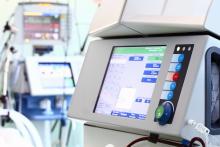National Healthcare Safety Network (NHSN)
The National Healthcare Safety Network (NHSN) is a national healthcare-associated infection (HAI) reporting system developed and maintained by the CDC (Centers for Disease Control and Prevention). It is the most widely used tracking system for HAIs in the United States. NHSN is used by health care providers to report surveillance data using standardized definitions to identify HAIs.
State-level NHSN data for Wisconsin hospitals are available in the HAI Prevention Program’s Annual HAI Data Report, P-00340. National-level data are available in CDC’s annual National and State HAI Progress Report. Hospital-specific data are available from the Wisconsin Hospital Association CheckPoint® and the CMS (Centers for Medicare & Medicaid Services) Care Compare websites.
Types of health care facilities that utilize NHSN
Health care facilities utilize NHSN for multiple reasons. NHSN's infection criteria and surveillance concepts are used to guide internal surveillance for HAIs, and to enable comparisons with state- and national-level HAI data. Many health care facility types also report HAI data into NHSN to meet federal health care quality reporting program requirements.
Below are the main health care facility types that utilize NHSN.
Acute care facilities
- Acute care hospitals
- Critical access hospitals
- Long-term acute care hospitals
- Inpatient psychiatric facilities
- Inpatient rehabilitation facilities
Long-term care facilities
Skilled nursing facilities
Other facility types
- Ambulatory surgery centers
- Outpatient dialysis facilities
HAI data reported in NHSN
While NHSN can be utilized by health care facilities to track a number of different infection types, the main HAIs tracked by hospitals in NHSN include:
- Catheter-associated urinary tract infections (CAUTI).
- Central line-associated bloodstream infections (CLABSI).
- Surgical site infections (SSI), primarily SSIs following colon surgeries, abdominal hysterectomies, and hip and knee replacement surgeries.
- Clostridioides difficile (C. difficile) infections.
- Methicillin-resistant Staphylococcus aureus (MRSA) bloodstream infections.
In addition to these conditions, hospitals also report on COVID-19 and influenza vaccination rates among health care personnel.
Skilled nursing facilities report information about the number of cases of COVID-19, influenza, and respiratory syncytial virus (RSV) among residents, resident and health care personnel COVID-19 vaccination rates, and health care personnel influenza vaccination rates.
Outpatient dialysis facilities report on specific events that can be indicators of infection in the dialysis setting, as well as COVID-19 vaccination rates for patients and staff.
Standardized infection ratio (SIR)
The SIR is the most widely used summary measure in NHSN. The SIR is the ratio of the number of observed healthcare-associated infections to the number of predicted infections. The SIR is risk-adjusted to account for the underlying risk of infection in the population being measured.
- A SIR >1 means that more infections were observed than predicted.
- A SIR <1 means fewer infections were observed than predicted.
- A SIR = 1 means there was no difference from the national baseline.
The SIR enables “apples to apples” comparisons of HAI data across facilities and hospital unit types, as well as comparisons with state and national data. For more information on the SIR, see NHSN’s Guide to the SIR (PDF).
NHSN data reports
NHSN data are incorporated into a number of different publicly available reports and websites:
- Wisconsin HAI Prevention Program Annual Data Report, P-00340: The HAI Prevention Program's annual data report includes state-level NHSN data for Wisconsin acute care and critical access hospitals.
- CDC’s National and State HAI Progress Report: Annual HAI progress report includes national- and state-level NHSN data for acute care, critical access, and long-term acute care hospitals; and for inpatient rehabilitation facilities.
- CMS CareCompare website: NHSN data are utilized for a number quality indicators on this website, including those shown for hospitals, outpatient dialysis facilities, and nursing homes.
- Wisconsin Hospital Association’s CheckPoint® website: NHSN data are used for several of the hospital health care quality indicators included on this website.
Support for NHSN users
The Wisconsin HAI Prevention Program actively supports Wisconsin NHSN users in all health care settings with one-on-one technical assistance, case consultation, monthly email reminders and clarifications, and monthly Wisconsin NHSN Users Calls.
Contact Nancy Eberle, HAI Prevention Program Surveillance Coordinator, at DHSWIHAIPreventionProgram@dhs.wisconsin.gov for assistance with NHSN access or reporting, or for more information about the monthly emails and NHSN Users Calls.
Looking for other HAI data?
The Wisconsin HAI Prevention Program provides reports and additional data on HAIs.
Questions about HAIs? Contact us!
Phone: 608-267-7711 | Fax: 608-261-4976




